
December 2006 - Copyright by Morris Rosenthal and Lewis Brown - contact info
- Traveling to Israel
- Hebrew Ulpan in Jerusalem
- Apartments and Rooms
- My Apartment Hunt
- Reading Real Estate Ads
- Nachalot Prices
- Rehavia Real Estate
- German Colony Apartments
- Home Renovation
- Commercial Construction
- Luxury Housing
- Stone Houses
- The Old City
- Food and Shopping
- Jerusalem Hotels
- Places to Learn
- Culture Shock
- Making Latkes
Copyright 2006 by Morris Rosenthal and Lewis Brown
All Rights Reserved
Potato Latkes from Chez Lewis in Jerusalem

|
Making latkes (potato pancakes) for Chanukah or any other time of the year requires commitment. Lewis began by peeling four pounds of potatoes, enough for latkes to feed four adults. He then proceeds to slice the potatoes into quarters, and then into smaller and smaller shoestrings, until the effect is exactly that of running them through a food processor. |
| Wait! Here's a suggestion from an unexpected quarter! A hungry child has spotted a flaw in the traditional potato slicing method, it takes too long. She hunts about Chez Lewis and comes up with an innovative approach. To get stringy shreds of potato just like a food processor, use a food processor. Thank you, Topaz. |
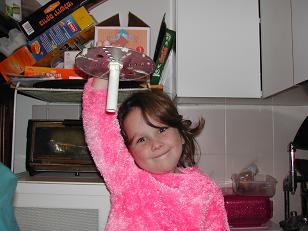
|
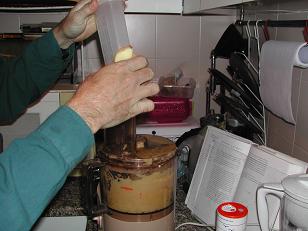
|
There's not too much exciting that can be said about putting peeled, quartered potatoes into a food processor and pushing them down onto the spinning blade. Just don't use your finger, the food processor comes with a plastic plunger for a reason. Lewis also peels, quarters and shreds one whole onion into the mixture. |
|
The shredded potatoes with onion are very wet (literary foreshadowing) and
want to stick in the food processor container. Lewis taps the side of the
container to get the shredded potato strings into the strainer.
|
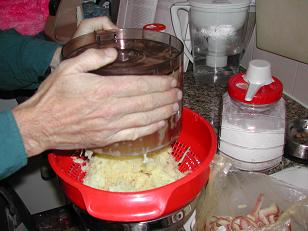
|
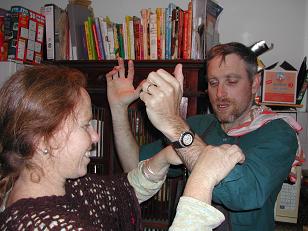
|
It's all been nice, clean kitchen work to this point, but here comes the part that separates the men from the boys. With the help of his lovely assistant, Yael, Chef Lewis "rolls up his sleeves" to get down to the hard work of making latkes. |
| Lewis starts by straining off the water oozing from the shredded potatoes, and helps the process along by squeezing and pressing against the walls of the strainer. Note that the liquid isn't being thrown away, but collected in a mixing bowl for further processing |
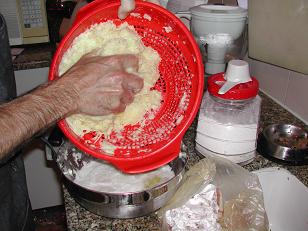
|
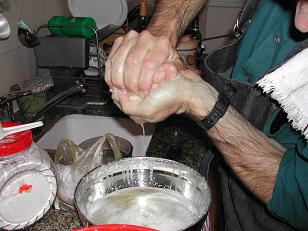
|
Now it's really time to flex those muscles as Lewis chases the remaining liquid out of the potatoes a handful at a time. It reminds me a the old story about the rabbi who defeats a circus strongman who challenges any onlooker to get even a drop of juice out of the orange he has crushed, but it's too long to repeat here. |
| Once all of the liquid is squeezed out of the potatoes, it's poured off into the sink, leaving behind a thick layer of white potato starch. The starch is set aside for a moment. |
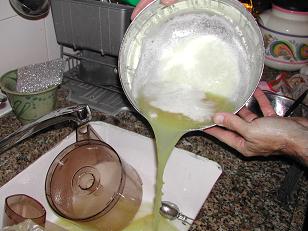
|
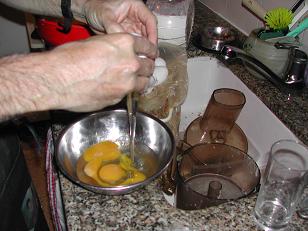
|
The recipe calls for one egg per pound of potatoes, and it's as good a time as any to crack them open into a fresh mixing bowl. |
|
No, he's not making an omelet, but the eggs must be beaten before adding
them to the starch, which helps glue the latkes together.
|
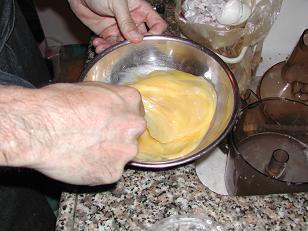
|

|
The beaten eggs are added to the starch, then the shredded potatoes are introduced to the bowl and the whole is mixed by hand. |
| The recipe calls for a quarter cup of flour, but Lewis only adds an eighth of a cup at this point. Why? It's a secret, at least for another couple steps. A tablespoon or two of salt gets tossed in the mix as well. |
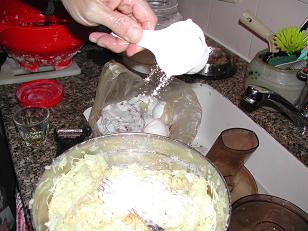
|

|
Nothing gets cooked at Chez Lewis without a healthy dose of freshly ground
black pepper, especially not latkes.
|
| All of the latke ingredients are in place at this point, and Lewis gives the mixture a final mixing. Don't get too energetic with the mixing at this point or you'll turn the shredded potatoes in pulp. Just try for a uniform slurry. |
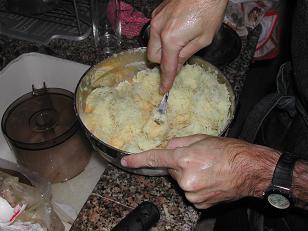
|

|
Before shaping the first latke, it's time to start heating up some oil. About an eighth of an inch in the bottom of the pan is enough for frying up latkes. A neutral vegetable oil like corn or sunflower oil is recommended. |
| Lewis shapes the first latke right on the spatula, and it sticks together like a good latke should. Don't get carried away with trying to make your latkes perfectly round or uniform in thickness. We aren't making fast food burgers. |

|
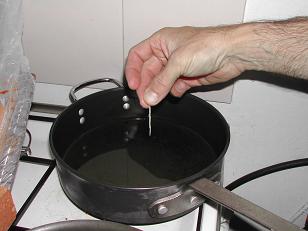
|
Before dropping a single latke into the pan, Lewis tests the oil by dipping in a single strand of potato to see if the oil is bubbling hot. If the oil doesn't bubble, do not stick your fingers into the pan to retrieve the test strand! |
| The latkes are placed in the oil one at a time. Lewis gets one edge of the latke submerged in oil before he lets the other edge slide off his fingers, which prevents splashing and burning. The bottle of beer in the foreground is not an endorsement of drinking and frying. |

|

|
There's no need to guess when a latke is cooked on one side, just pick up the edge with your spatula and check it. If the latke falls apart, you probably didn't squeeze out enough liquid - your fault, not ours:-) |
| Every cookbook needs a beauty shot. Look at those four lakes frying away after they've been turned. The Maccabees never had it so good, well, except for the part about being kings. |
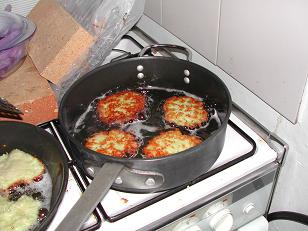
|

|
Since it takes a while to prepare enough latkes for a family, Lewis uses a clay vessel to keep them warm. Note the aluminum foil under the paper towel to keep the oil from ruining the earthenware. |
| The whole vessel, lid in place, is placed into the oven at around 70 degrees Celsius. That's around 160 degrees in the other temperature scale that I couldn't figure out how to spell even with a spell checker. |
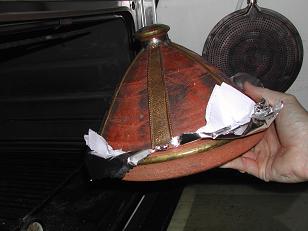
|
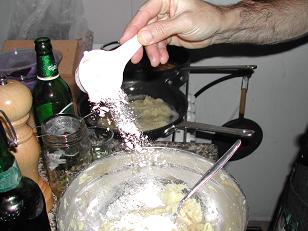
|
Now we get to the secret. Lewis adds another eighth of a cup of flour to the latke mixture which has had a chance to relax and which weeps a little moisture. A quick mix, and it's time to fry the next batch. |
| Another layer ready the oven, but the natives are getting restless. An old Jewish proverb says, "When you set out to cook latkes, eat something first so you won't get hungry on the journey." |

|
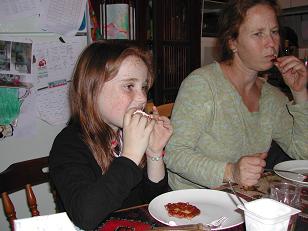
|
Finally, it's time to start eating those Latkes. Cheer up Yael, your African cucumber salad got the silver medal, but you just can't compete with latkes:-) |